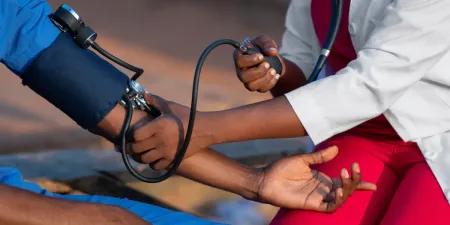
Sickle cell anemia is a genetic disease that primarily affects individuals of African descent. It is acquired from birth when parents carry the diseased genes. Let's explore this disease, which often has serious consequences for those who suffer from it.
What is sickle cell anemia?
Sickle cell anemia is a genetic disease that primarily affects individuals of African descent. It is characterized by an alteration in the normal structure of hemoglobin (a constituent of blood), resulting in a deformation of red blood cells into sickle-shaped cells, known as 'sickle cells'. These deformed red blood cells have difficulty circulating in the bloodstream and can become lodged in small-diameter vessels, leading to the onset of harmful manifestations of the disease: so-called 'vaso-occlusive crises' and anemia due to their shorter lifespan. Additionally, individuals with this condition have a higher tendency to develop infections. This is known as sickle cell syndrome.
What causes it?
Sickle cell anemia is caused by an alteration in the normal structure of hemoglobin, resulting in a deformation of red blood cells into sickle-shaped cells, known as sickle cells. This deformation is conditioned by the presence of a specific gene from each of the two parents: the S gene. This genetic disease is autosomal recessive, which means in simple terms that for it to express itself, the gene in question must be expressed twice, thus coming from both parents. Therefore, we distinguish:
Individuals homozygous for AA (where the S gene is not present). These individuals do not have the disease and cannot transmit the risk gene to their offspring.
Individuals heterozygous for AS (where the S gene is present only once). They do not manifest the disease but have a 50% chance of transmitting the gene to their offspring.
Individuals homozygous for SS (where the S gene is present twice). These individuals manifest the disease and have a 100% chance of transmitting the risk gene to their offspring.
We also distinguish individuals who are double heterozygotes or thalassemic sickle cell carriers, who may exhibit signs of sickle cell syndrome.
What are the symptoms of sickle cell disease?
Symptoms of the disease depend on age and the severity of sickle cell disease. Infants are generally asymptomatic because they still benefit from the presence of fetal hemoglobin, which disappears later. Major symptoms observed include:
Anemia: Altered hemoglobin S weakens red blood cells, leading to their premature destruction in just 20 days instead of the normal 120 days in case of normal hemolysis. This destruction results in an abnormal decrease in red blood cell count and manifests as pallor, chronic fatigue, and even yellowing of the eyes and skin (jaundice). This chronic anemia is often well tolerated by patients with sickle cell disease, except in cases of complications such as acute splenic sequestration or infections, where anemia can worsen suddenly.
Vaso-occlusive crises: As mentioned earlier, sickle cell disease is characterized by an alteration in the structure of hemoglobin, a component of blood. This alteration causes a change in the shape of red blood cells into sickle-shaped cells, making it difficult for them to move in the bloodstream, especially in small-diameter blood vessels. They can accumulate there and obstruct blood circulation at that level. These crises generally cause sharp, severe pain, most often affecting the bones and joints of the arms, legs, back, or chest.
Hand-foot syndrome: This is a form of vaso-occlusive crisis mainly seen in young children. It manifests as painful swelling of the hands and feet.
Acute chest syndrome: It is the leading cause of death in sickle cell patients. It is a vaso-occlusive crisis affecting the vessels of the lungs, which supply oxygen to the entire body. This crisis manifests as chest pain, associated with breathing difficulties, sometimes accompanied by fever.
Stroke: They occur very frequently in people with sickle cell disease and have multiple manifestations: headaches, paralysis, language disorders, etc. Although these manifestations are often transient, they can sometimes cause serious sequelae.
Recurrent infections: The spleen, an important organ in the body's immunity against infections, is severely affected in sickle cell patients. It is often affected by vascular occlusions and no longer efficiently performs its role. Therefore, sickle cell patients are often at risk of contracting recurrent infections. These infections contribute to the manifestation of other symptoms such as anemia and vascular occlusions.
Long-term complications of sickle cell disease include growth retardation, later puberty than usual, various organ damage such as bones and joints, eyes, liver, lungs (causing pulmonary hypertension), and even kidneys (causing renal failure), or the gallbladder (causing gallstones)
How to prevent sickle cell disease?
Sickle cell disease is not an infectious disease but a genetic one. It is acquired from birth if one is a carrier of the mutated gene. Therefore, it is not possible to talk about avoiding the disease; however, it is possible to prevent its transmission to offspring. For this, it is important to know initially whether one is a carrier of the S gene or not. An examination is available for this, known as hemoglobin electrophoresis: It indicates whether one is AA (absence of the S gene, no risk of transmitting the disease), AS (presence of an S gene, no manifestation of the disease but the risk of transmission is present), or SS (double presence of the S gene, manifestation of the disease, and transmission to offspring).
Thus, it is considered that a couple AA+AA has 0% chance of having a sickle cell child, as well as a couple AA+AS. On the other hand, a couple AS+AS has a 25% chance of having a sickle cell child, a couple AS+SS has a 50% chance of having a sickle cell child, and a couple SS+SS has a 100% chance of having a sickle cell child.
This examination, hemoglobin electrophoresis, is recommended for all couples desiring to have a child. In our context (Cameroon), it is systematically prescribed for all pregnant women and newborns. It is therefore important to know one's hemoglobin electrophoresis and not to forget it, and also to ask the question to one's partner.
Does sickle cell disease have a cure?
Scientific advancements in understanding this disease have improved its management and increased the life expectancy of those who suffer from it. Today, patients with sickle cell disease live on average until about 40 years old, compared to 20 years old in 1980. Rigorous medical follow-up is key, starting from early diagnosis at birth or even before. Moreover, prevention remains one of the main pillars for its eradication: it involves, for anyone wishing to conceive, knowing their hemoglobin electrophoresis and that of their partner, and seeking medical care even before conception if there are any risks.
key takeaways
Sickle cell disease is a genetic condition primarily affecting individuals of African descent, characterized by abnormal hemoglobin structure leading to sickle-shaped red blood cells. Symptoms vary with age and disease severity, ranging from anemia and vaso-occlusive crises to acute chest syndrome and strokes. While the disease is not curable, early diagnosis through hemoglobin electrophoresis enables proactive medical management, significantly improving patient outcomes. Couples planning to conceive should undergo genetic screening to assess their risk of transmitting the disease to their offspring. With advancements in medical understanding and proactive healthcare, individuals with sickle cell disease can now live longer, emphasizing the importance of preventive measures and ongoing medical supervision.


